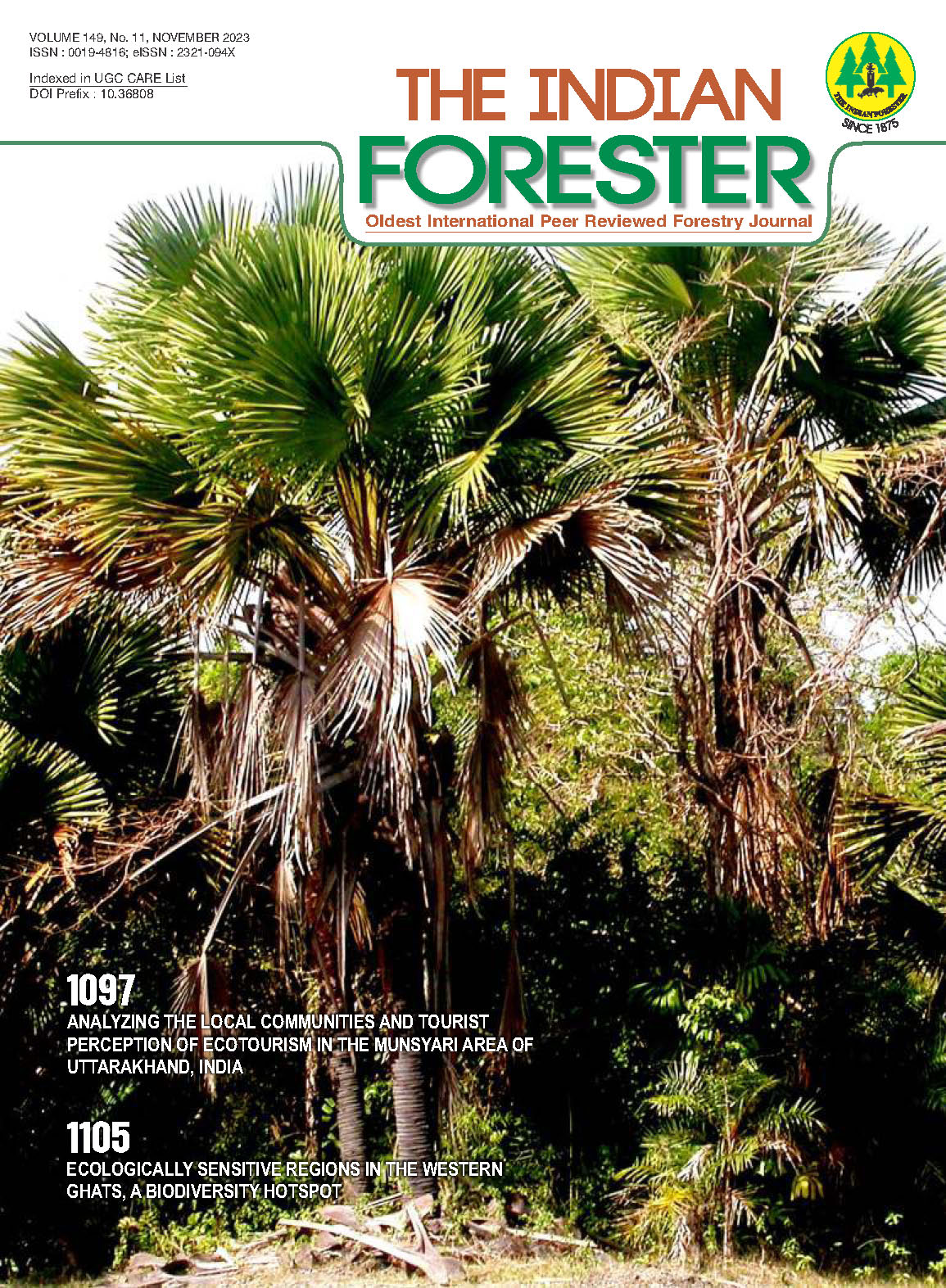Antimicrobial Potential of Some 1, 2-Diazole Derivatives for Food Safety and Microbial Pollution
DOI:
https://doi.org/10.36808/if/2023/v149i11/169727Keywords:
Antimicrobial, Antibacterial, Antifungal Activities, 1, 2-Diazole Derivatives, Pollution.Abstract
The microbial pollution is of serious concern in terms of its impacts on health of human beings, animals and plants. A great number of food borne diseases and outbreaks are caused due to contamination of fresh produce and animal products from polluted sources with pathogenic bacteria, viruses and protozoa. In present study, some derivatives of 1,2-Diazols like 3-Methyl-5-phenyl-4-azophenyl-(4-sulphonamido-N-pyrimidine)-N-(p-hydroxybenzoyl)-1,2-diazole, 3-Ethyl-5-phenyl-4-azonitrophenyl-N-(p-hydroxybenzoyl)-1,2-diazole(8), 3-Ethyl-5-phenyl-4-(azo-N,N-dimethyaniline) N-(phydroxybenzoyl)-1,2-diazole(9), and 3-Ethyl-4-(azophenyl)-5-phenyl-N-(p-hydroxybenzoyl)-1,2-diazole(10) were synthesized in laboratory by the process of suitable chemical reactions. The antimicrobial potential of these 1, 2-Diazols derivatives was studied against some microorganisms commonly found in polluted habitats. The antibacterial activity was studied against Escherichia coli, Pseudomonas aeruginosa, Yersinia pestis, Clostridium botulinum and Streptococcus pyogenes; and antifungal activity was studied against Candida albicans, Aspergillus niger, Trichophyton rubrum and Aspergillus clavatus. The structure of these synthesized 1 chemical compounds was elucidated by IR and H-NMR spectroscopy and elemental analyses.References
Alum E.A., Urom S.M.O.C. and Ben C.M.A. (2016). Microbiological Contamination Of Food: The Mechanisms, Impacts And Prevention. Int. J. Of Scientific & Tech. Research, 5(3): 65-78.
Bhatt B.A., Dhar K.L., Puri S.C., Saxena A.K., Shanmugavel M. and Qazi G.N. (2005). Synthesis and Biological Evalution of Chalcones and their derived Pyrazoles as potential Cytotoxic Agent. Bioorganic & Medicinal Chemistry Letters, 15: 3177-3180.
Bintsis T. (2017). Food borne pathogens. AIMS Microbiol., 3: 529–563.
Buck J., Walcott R. and Beuchat L. (2003). Recent trends in microbiological safety of fruits and vegetables. Plant Health Progress, 4(1): 25.
Delaquis P, Bach S. and Dinu L.D. (2007). Behavior of Escherichia coli O157:H7 in leafy vegetables. J Food Protect, 70: 1966–1974.
Elizabeth A.B. and Robert B.G. (2006). Role of good Agricultural Practices in fruit and vegetable safety. In Karl R. Mathews (2006). Emerging Issues in food Safety. Microbiology of fresh produce, ASM Press, Washington, D. C. Pp. 21.
GarcÃa A.V. and Hirt H. (2014). Salmonella enterica induces and subverts the plant immune system. Front Microbiol., 5: 141.
Harathai P., Rajendra Prasad, V.V.S., Satyavati, D., Siva subramanian V.B. and Prashanthi G. (2015). Asian journal of pharmaceutical and clinical research, 8: 5.
Kalirajan R., Sivakumar S.U., Gowramma J.B. and Suresh B. (2007). Synthesis and biological Evaluation of some Hetrocyclic Derivative Chalcones. Int. J. of Chemical Sciences, 5: 73-80.
Kavitha C.V., Basappa S., Nanjunda S., Mantelingu K., Doreswamy S., Sridhar M.A., Prasad J.S. and Rangappa K.S. (2006). Synthesis of new bioactive venlafaxine analogs Novel thiazolidin- 4-one as antimicrobials. Bioorga. Med. Chem., 14: 2290.
Kucukguzel G., Kocatepe A., Clereq E.De, Sahin F. and Gulluce M. (2006). Synthesis and biological activity of 4-thiazolidinones, thiosemicarbazides derived from diflunisal hydrazide. Eur. J. Med. Chem., 41: 353.
Ottana R., Maccari R., Barreca M.I., Bruno G., Rotondo A., Rossi A., Chiricosta G., Paola R.Di,. Sautebin I., Cuzzocrea S. and Vigonta M.G. (2005). 5-Arylidene-2-imino4-thiazolidinones Design and synthesis of novelanti-infammatory agents. Bioorg. Med. Chem., 13: 4243.
Rashad A.E., Shamrokh A.H., Hegab M.I. and Awad H.M. (2005). Synthesis of some Biologically active Pyrazoles and C-Nucleoside. Acta Chimica Slovenica, 52: 429-434.
Ray R.U., Desai A.R. and Desai K.R. (2005). Synthesis and Antimicrobial Activity of 1,2,4-Thiazole. E-Journal of Chemistry, 2(6): 1.
Singh R.K., Iqbal S. and Seth P.C. (2001). Bacteriological pollution in a stretch of river Narmada at Hoshangabad, Madhya Pradesh.Poll.Res.,20:211-213.
Some S., Mondal R., Mitra D., Jain D., Verma D. and Das S. (2021). Microbial pollution of water with special reference to coliform bacteria and their nexus with environment. Energy Nexus, 1: 01-09.
Stier R.F. and Odumeru J. (2001). Growers Beware: Adopt Good Agricultural Practices (GAPs) or Else. Food safety magazine (Oct. – Nov.). 26 – 32.
Vibhute Y.B. and Baseer M.A. (2003). Synthesis and Activity of a New Series of Chalcones as Antibacterial Agents. Indian Journal of Chemistry, 42: 202-205.
Vigorita M.G., Ottana R., Manforte F., Maccari R., Trovata A., Monforte M.T. and Taviano M.F. (2001). Synthesis and anti-infammatory and analgesic activity of 3,3,-(1,2-ethandiyl)-bis [2-aryl-4-thiazolidinone] chiral compounds. Bioorg. Med. Chem., 11: 2791.
WHO. (2014). Food safety issues: surface decontamination of fruits and vegetables eaten raw: a review. WHO, Geneva, Switzerland (http://www.who.int/foodsafety/publications).
Downloads
Downloads
Published
How to Cite
Issue
Section
License
Unless otherwise stated, copyright or similar rights in all materials presented on the site, including graphical images, are owned by Indian Forester.





